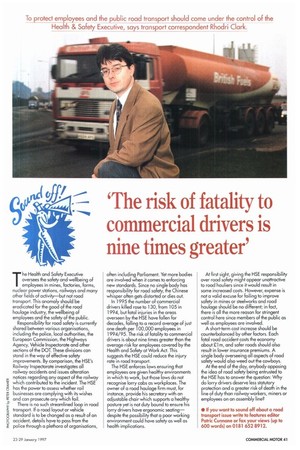'The risk of fatality to commercial drivers is nine times greater'
Page 43

If you've noticed an error in this article please click here to report it so we can fix it.
The Health and Safety Executive oversees the safety and wellbeing of employees in mines, factories, farms, nuclear power stations, railways and many other fields of activity—but not road transport. This anomaly should be eradicated for the good of the road haulage industry, the wellbeing of employees and the safety of the public.
Responsibility for road safety is currently shared between various organisations, including the police, local authorities, the European Commission, the Highways Agency, Vehicle Inspectorate and other sections of the DOT. These divisions can stand in the way of effective safety improvements. By comparison, the HSE's Railway Inspectorate investigates all railway accidents and issues alteration notices regarding any aspect of the railway which contributed to the incident. The HSE has the power to assess whether rail businesses are complying with its wishes and can prosecute any which fail. There is no such streamlined loop in road transoort. If a road layout or vehicle stancard is to be changed as a result of an accident, details have to pass from the police through a plethora of organisations, often including Parliament. Yet more bodies are involved when it comes to enforcing new standards. Since no single body has responsibility for road safety, the Chinese whisper often gets distorted or dies out.
In 1995 the number of commercial drivers killed rose to 130, from 105 in 1994, but fatal injuries in the areas overseen by the HSE have fallen for decades, falling to a record average of just one death per 100,000 employees in 1994/95. The risk of fatality to commercial drivers is about nine times greater than the average risk for employees covered by the Health and Safety at Work Act. This suggests the HSE could reduce the injury rate in road transport.
The HSE enforces laws ensuring that employees are given healthy environments in which to work, but those laws do not recognise lorry cabs as workplaces. The owner of a road haulage firm must, for instance, provide his secretary with an adjustable chair which supports a healthy posture yet is not duty bound to ensure his lorry drivers have ergonomic seating— despite the possibility that a poor working environment could have safety as well as health implications. At first sight, giving the HSE responsibility over road safety might appear unattractive to road hauliers since it would result in some increased costs. However, expense is not a valid excuse for failing to improve safety in mines or steelworks and road haulage should be no different; in fact, there is all the more reason for stringent control here since members of the public as well as employees are involved. A short-term cost increase should be counterbalanced by other factors. Each fatal road accident costs the economy about C1m, and safer roads should also result in lower insurance premiums. A single body overseeing all aspects of road safety would also weed out the cowboys. At the end of the day, anybody opposing the idea of road safety being entrusted to the HSE has to answer the question: Why do lorry drivers deserve less statutory protection and a greater risk of death in the line of duty than railway workers, miners or employees on an assembly line?
• If you want to sound off about a road transport issue write to features editor Patric Cunnane or fax your views (up to 600 words) on 0181 652 8912.
































































































